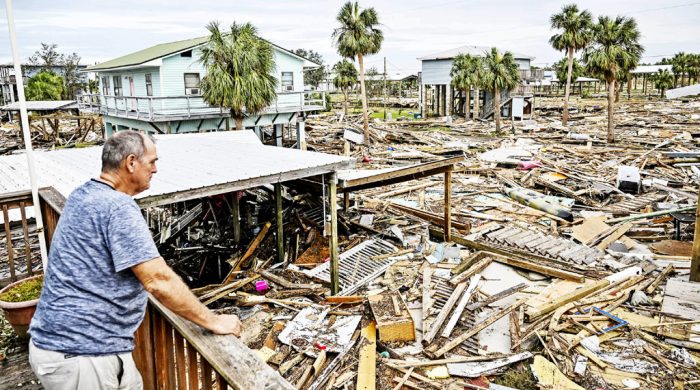Storm Helene kills 44 in US, 59 dead in Nepal floods

- Update Time : Sunday, September 29, 2024
- 25 Time View

Nearly four million Americans were still in the dark and many faced torrential flooding on Saturday, authorities said, as powerful storm Helene marched across eastern US states, leaving at least 44 people dead.
Emergency responders had launched massive rescue operations across multiple states since Helene slammed into Florida as a Category 4 hurricane and surged north, leaving roads, homes and businesses underwater—many of them destroyed.
Power had been restored in some areas since night fell over the region Friday, but nearly four million customers were still without electricity across 10 states in the early hours of Saturday, according to tracker poweroutage.us, with US meteorologists warning of possible ‘long-duration’ outages.
Record-breaking river flooding hit several southern states, the NHC said, with massive flooding reported in Asheville, a city in western North Carolina.
In Cedar Key, an island city of 700 people just off Florida’s northwest coast, the full destructive force of the hurricane was on view.
Several pastel-colored wooden homes were completely destroyed, victims of storm surge and ferocious winds.
In South Carolina at least 20 people have died, including two firefighters, officials said. Among the deaths were six residents of Spartanburg County, according to county coroner Rusty Clevenger.
Georgia Governor Brian Kemp’s office confirmed 15 people were killed in his state, including an emergency responder. Kemp warned that the city of Valdosta had identified 115 heavily damaged structures with multiple people trapped inside.
Florida’s toll stood at seven. Governor Ron DeSantis said the damage from Helene exceeded that of hurricanes Idalia and Debby, which both hit the same Big Bend region southeast of Tallahassee in the last 13 months.
In Perry, near where Helene slammed ashore bearing winds of 140 miles (225 kilometers) per hour, houses lost power and the gas station was flattened.
Four hundred miles to the north in the Tennessee town of Erwin, a dramatic rescue operation unfolded, as more than 50 patients and staff were trapped on a hospital roof as floodwaters raged around them, local television footage showed. Helicopters were deployed in the rescue.
Local media reported multiple deaths in North Carolina.
Meanwhile, Floods and landslides triggered by heavy downpours in Nepal killed at least 59 people across the Himalayan country, with rescue teams searching for 44 missing, police said Saturday.
Rain-related disasters are common in South Asia during the monsoon season from June to September, but experts say climate change is increasing their frequency and severity.
Large swathes of Nepal have been inundated since Friday, prompting disaster authorities to warn of flash floods in multiple rivers.
‘So far, there are 59 dead, 36 wounded and 44 missing,’ Nepal police spokesman Dan Bahadur Karki told AFP.
Karki said more than 200 incidents of flood and landslides have been reported and that the toll was likely to increase further.
Rivers around the capital Kathmandu burst their banks, inundating nearby houses.
Basanta Adhikari, a spokesman for Nepal’s National Disaster Risk Reduction and Management Authority, said authorities were working to rescue and get relief to those impacted by the floods.
More than 3,000 security personnel were deployed to assist rescue efforts with helicopters and motorboats.
Rescue teams were using rafts to pull survivors to safety.
Landslides have blocked several highways, leaving hundreds of travellers stranded.
All domestic flights out of Kathmandu were cancelled from Friday evening, affecting more than 150 departures.
The summer monsoon brings South Asia 70-80 percent of its annual rainfall.
Monsoon rains from June to September bring widespread death and destruction every year across South Asia, but the numbers of fatal floods and landslides have increased in recent years.
Experts say climate change has worsened their frequency and intensity.
A landslide that hit a road in Chitwan district in July pushed two buses with 59 passengers aboard into a river.
Three people were able to escape alive, but authorities managed to recover only 20 bodies from the accident, with raging flood waters impeding the search.
More than 220 people have died in Nepal in rain-related disasters this year.















